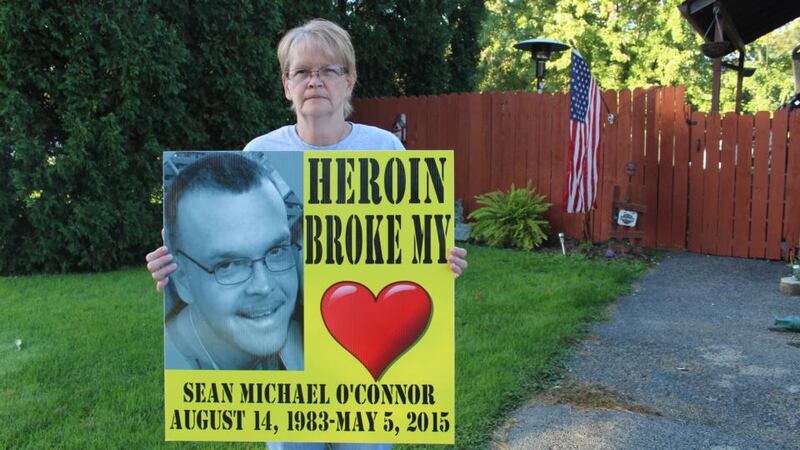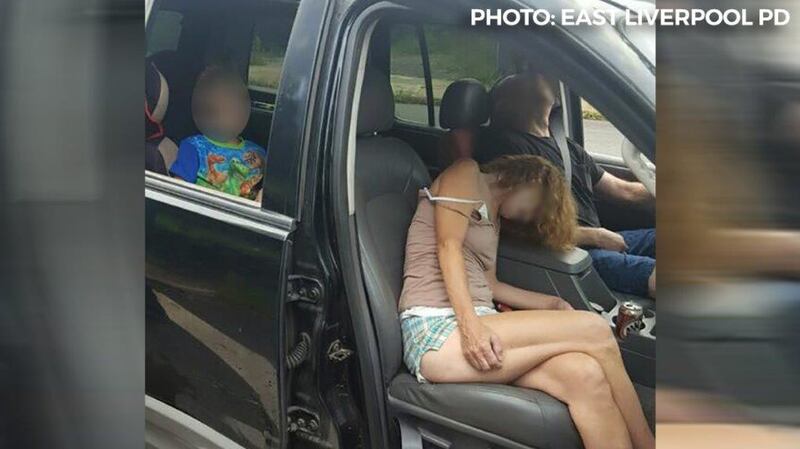Five-year-old Liam Atticus O’Connor knows that his daddy got sick and is in heaven now, his grandmother Cindy Anderson says. The little boy likes to make things and leave them beside his father’s ashes, in their living room.
"He goes, 'I made that for my daddy,' " says Anderson, sitting in her home, near the town of Columbiana, in eastern Ohio, next to a photograph of her late son.
The 53-year-old first learned that her son, Sean Michael O’Connor, was a heroin addict when Liam was born. A doctor told her as O’Connor’s wife, also an addict, was going into labour that their baby would be born an addict too.


“We didn’t know anything about heroin,” Anderson says about hearing that O’Connor was an addict. “We would just ask him, ‘Just stop, just stop doing it.’ Now we realise that you just can’t stop doing it.”
Anderson lives in the economically depressed area of Appalachia, which was once an engine of American manufacturing, with bustling steel, coal and ceramics industries. Today the mills, mines and factories are closed or in decline, and the lives of the people here are crumbling from the opioid epidemic sweeping the state and many other parts of the US. Ohio is a battleground in the US presidential election and a must-win state for Donald Trump.
Anderson traces her son’s problems to a car crash 13 years ago. He was driving with his best friend when he lost control and went over an embankment. O’Connor walked away; his friend was killed. They were both 18. O’Connor began self-medicating to deal with the untreated psychological trauma from the crash. He started with illegally obtained prescription drugs and ended up hooked on heroin – which was cheaper – for about six years. It is a common route to opioid addiction in these parts.
By May 5th, 2015, O’Connor had been off drugs for four months – his longest clean stretch – when a friend who was a known drug user came to his apartment. O’Connor’s body was found a few hours later. There was a single mark on his arm. He died of an overdose of fentanyl, a synthetic opioid that can be 50 times stronger than heroin.
Last month Ohio’s drug problem made headlines around the world when police posted a photograph on Facebook of an overdosing couple passed out one afternoon in their car with a four-year-old boy restrained in his seat in the back. The incident happened in East Liverpool, a town 25 minutes from Anderson’s home. “A lot of people were offended and appalled, but that photo had an impact,” she says.
The photograph highlighted a crisis plaguing communities across the US, particularly poor rural counties, such as Columbiana, which lack the financial resources and support services to address it.
“We had to get Columbus’s attention,” says Brian Allen, the East Liverpool director of public service and safety, referring to the state government, in its capital. “They have a $2 billion rainy-day fund there, and we wanted the message to get to Columbus that it is storming here and the flood waters are rising.”
Attention
The city, which has about 11,000 residents, certainly did get the state’s attention. On Tuesday Ohio’s attorney general, Mike DeWine, a former two-term US senator, travelled to the town of Lisbon, the Columbiana county seat, to attend a public forum of elected representatives, law enforcement officials, prosecutors and health officials on how to deal with the epidemic.
DeWine acknowledged the impact of the Facebook post. “The photo in East Liverpool went around the world, but I don’t think anybody in law enforcement or anybody who deals with this, anybody who is an emergency-room doctor or nurse, anybody in a coroner’s office, anybody who deals with this every day was . . . surprised,” he told the meeting.
The epidemic was unlike any he had seen in his 40-year career as a prosecutor and politician, he said, because it was everywhere, in cities, in suburbs and in rural counties. “It is pervasive,” he said. “The face of heroin is merely the face of Ohio.”
The statistics behind the drug problem are shocking. Last year in Ohio somebody died from a drug overdose every two hours and 52 minutes – more than eight a day – according to the state’s department of health. Drug deaths topped 3,050 in Ohio last year, 20 per cent more than in 2014. Illegally produced fentanyl, some sent from China, killed 1,155 people, which was more than double the number killed by the drug in 2013.
Ohio is but a microcosm of the country. There were 47,055 drug-overdose deaths in the US in 2014, according to the Centers for Disease Control and Prevention. The number from synthetic opioids such as fentanyl rose by 80 per cent in two years. Appalachia was one of the worst-affected areas. Ohio had the fifth-highest number of deaths, after West Virginia, New Mexico, New Hampshire and Kentucky.
The United Nations' World Drug Report 2016 found that cheap drugs have pushed the number of heroin users in the US to about a million, the highest for 20 years and almost three times as many as in 2003.
On Tuesday an exasperated Lieut Brian McLoughlin, director of Columbiana County drug task force, offered some local statistics. There had been 20 confirmed overdose deaths in the county this year, including one in the previous 12 hours, putting Columbiana on course to surpass last year’s 27 overdose deaths.
McLoughlin said that the data does not include addicts saved by the opioid-reversing drug naloxone, such as the couple in the car in East Liverpool. One paramedic told him: “I don’t remember the last time I worked a shift where I didn’t bring someone back.”
Brandi Phillips, chief inspector at Columbiana County coroner’s office, recalled another emergency medic telling her that one day they brought back the same addict twice. “It’s ridiculous,” she told the meeting. “I don’t have an answer either. I can tell you what the outcome is: they either end up in jail or dead.”
Brian Allen, the public-safety director, says that the availability of naloxone is encouraging addicts to abuse drugs in public, so explaining the couple in the car. "If they do it in the privacy of their own home and nobody knows, they end up dead," he tells The Irish Times.
Amid much frustration at Tuesday’s meeting some of the problems identified as facing Ohio officials were the absence of quick-detox facilities and long-term residential treatment, and the lack of an awareness programme to educate schoolchildren as young as five about the dangers of drugs. The counties hugging the Ohio River are the poorest in the state, and have its lowest educational rates.
Treatment
Josh Lytle, who has been clean of drugs for almost 11 years, works as a counsellor, trying to encourage addicts at their lowest point to embrace treatment that aims to boost their self-esteem.
The 34-year-old went through a faith-based rehabilitation in West Virginia called Appalachian Teen Challenge, which has an 86 per cent long-term success rate for recovering addicts. The vast majority of addicts who initially go through a crisis centre end up clean in the long term; the success rate is just 20 per cent if they don’t, he says.
“It like control-alt-delete on a computer,” he says. “You really have to start over, teach them how to shake hands, hold their head up and not walk in shame. It’s the normal little things in life that they didn’t do.”
That’s the demand side. On the supply side Donald Trump offers one solution. The Republican presidential candidate has said that his plan to build a wall along the border with Mexico will solve the opioid epidemic and stop the flow of heroin into the country.
This is one reason why Trump is popular in parts of the American rust belt. His statement about drugs coming into the country across the southern border is, in fact, one of his accurate statements about Mexico. The US Drug Enforcement Administration said last year that “Mexico and, to a lesser extent, Colombia dominate the US heroin market, because of their proximity, established transportation and distribution infrastructure, and ability to satisfy US heroin demand”.
Bill Johnson, a US congressman from Ohio and a Trump supporter, tells The Irish Times that the Republican nominee's plan to close the country's "porous borders" 2,500km to the south will "absolutely" help to address the drug epidemic in his home state.
Heroin comes into the rural parts of Ohio from the cities of Cincinnati, Cleveland and Pittsburgh, where the drug costs as little as $3 or $4 a bag. Dealers are drawn to rural areas for the mark-up to $8 or $10 a bag, flooding surrounding counties with opioids and feeding the habits of the addicted rural poor.
Cindy Anderson still plans to vote for Trump, even if she believes his wall plan is simplistic. She is definitely not voting for Hillary Clinton, whom she sees as another politician passing ineffective laws. "I agree on Trump's thoughts, but do I believe it is possible? No. Drugs are going to get us one way or another. But his theory is awesome," she says.
Lytle says that the problem runs far deeper than anything a wall could solve. “Putting a wall up could stop a lot of it, but I think people will still find ways if they are hurting,” he says.
Lytle and his father run a charity called Family Care Excellence, to give addicts the 60- to 90-day care that can help them move on to longer-term rehabilitation. Lytle’s contact details and services have been advertised on bumper stickers in eastern Ohio.
Anderson is also trying to stop the hurt. She and her husband, Edward, have set up a charity, Sean’s Bridge to Hope, to help place addicts in rehabilitation facilities, bring drug education to schools and teach families not to enable relatives who are addicts. About 200 people attended an awareness-raising walk organised by the Andersons in East Liverpool a few days before the overdose photograph appeared.
“People say to you, ‘Your fight is over.’ But our fight isn’t over, because there is another mother out there losing a child, another family losing a loved one,” she says. “We want our lessons to be lessons for others before they lose anyone.”











